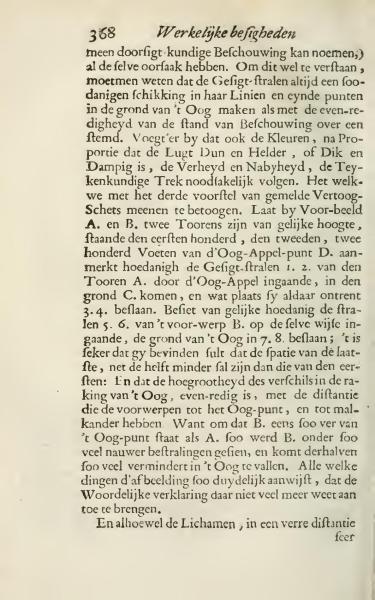Actual Observations
which one could call insightful considerations;) all have the same cause. To understand this well, one must know that the rays of vision always make such a formation in their lines and end points at the foundation of the Eye, corresponding with the even lay of sight over a certain area. Also consider the Colors, in proportion as the Air is Thin and Clear, or Thick and Foggy, the Height and Nearness, the Artistic Traits must necessarily follow. This is what we intend to demonstrate with the third proposal of the mentioned Diagram. For example, let A. and B. be two towers of equal height, standing one hundred, the second, two hundred feet from the Eye Pupil-Point D. to perceive how the rays of vision 1. 2. from the tower A. entering through the Eye-Pupil, reach the ground C., and what places they cover around 3. 4. Consider how the rays 5. 6. of object B. in the same way reaching, the foundation of the Eye at 7. 8.; it is certainly true that you will find the spaces of the later, are half less than those of the former: Thus, the magnitude of the differences in the ranking of the Eye, is proportional with the distance that the objects have to the Eye-point, and to one another. Because B. is once so far from the Eye-point as A., so B. was under so much narrower radiation, thus much less falls into the Eye. All these matters the image so clearly indicates, that the Literal explanation barely adds anything. — And therefore even though the Bodies, at a far distance make
The text discusses how visual perception works, emphasizing the parallel between the formation of vision rays in the eye and visual observation. It explains how the characteristics of colors, distance, and height must be considered in this visual arrangement. A diagram is used to demonstrate this, comparing the perspective of two towers at different distances from the eye and how this affects perception.
